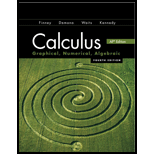
MRAMn is always the average of LRAMn and RRAMn.
Answer to Problem 38E
The average of LRAM and RRAM is not always equal to MRAM.
Explanation of Solution
Given information:
MRAMn is always the average of LRAMn and RRAMn.
Formula used:
The LRAM and RRAM is used.
Calculation:
Statement is false.
For example,
For
Now take average of LRAM1 and RRAM1
It is not equal to MRAM1.
Sometime average Of LRAM and RRAM is equal to MRAM.
Take,
Now take average of LRAM1 and RRAM1
It is not equal to MRAM1
Sometime average of LRAM and RRAM is equal to MRAM.
Take,
Now take average of LRAM1 and RRAM1
It is equal to MRAM1.
So, above from two examples hence the average of LRAM and RRAM is not always equal to MRAM. Sometimes it is equal, sometime not.
Conclusion:
The average of LRAM and RRAM is not always equal to MRAM.
Chapter 6 Solutions
Calculus 2012 Student Edition (by Finney/Demana/Waits/Kennedy)
Additional Math Textbook Solutions
Calculus: Early Transcendentals (2nd Edition)
University Calculus: Early Transcendentals (4th Edition)
Elementary Statistics: Picturing the World (7th Edition)
A First Course in Probability (10th Edition)
 Calculus: Early TranscendentalsCalculusISBN:9781285741550Author:James StewartPublisher:Cengage Learning
Calculus: Early TranscendentalsCalculusISBN:9781285741550Author:James StewartPublisher:Cengage Learning Thomas' Calculus (14th Edition)CalculusISBN:9780134438986Author:Joel R. Hass, Christopher E. Heil, Maurice D. WeirPublisher:PEARSON
Thomas' Calculus (14th Edition)CalculusISBN:9780134438986Author:Joel R. Hass, Christopher E. Heil, Maurice D. WeirPublisher:PEARSON Calculus: Early Transcendentals (3rd Edition)CalculusISBN:9780134763644Author:William L. Briggs, Lyle Cochran, Bernard Gillett, Eric SchulzPublisher:PEARSON
Calculus: Early Transcendentals (3rd Edition)CalculusISBN:9780134763644Author:William L. Briggs, Lyle Cochran, Bernard Gillett, Eric SchulzPublisher:PEARSON Calculus: Early TranscendentalsCalculusISBN:9781319050740Author:Jon Rogawski, Colin Adams, Robert FranzosaPublisher:W. H. Freeman
Calculus: Early TranscendentalsCalculusISBN:9781319050740Author:Jon Rogawski, Colin Adams, Robert FranzosaPublisher:W. H. Freeman
 Calculus: Early Transcendental FunctionsCalculusISBN:9781337552516Author:Ron Larson, Bruce H. EdwardsPublisher:Cengage Learning
Calculus: Early Transcendental FunctionsCalculusISBN:9781337552516Author:Ron Larson, Bruce H. EdwardsPublisher:Cengage Learning





